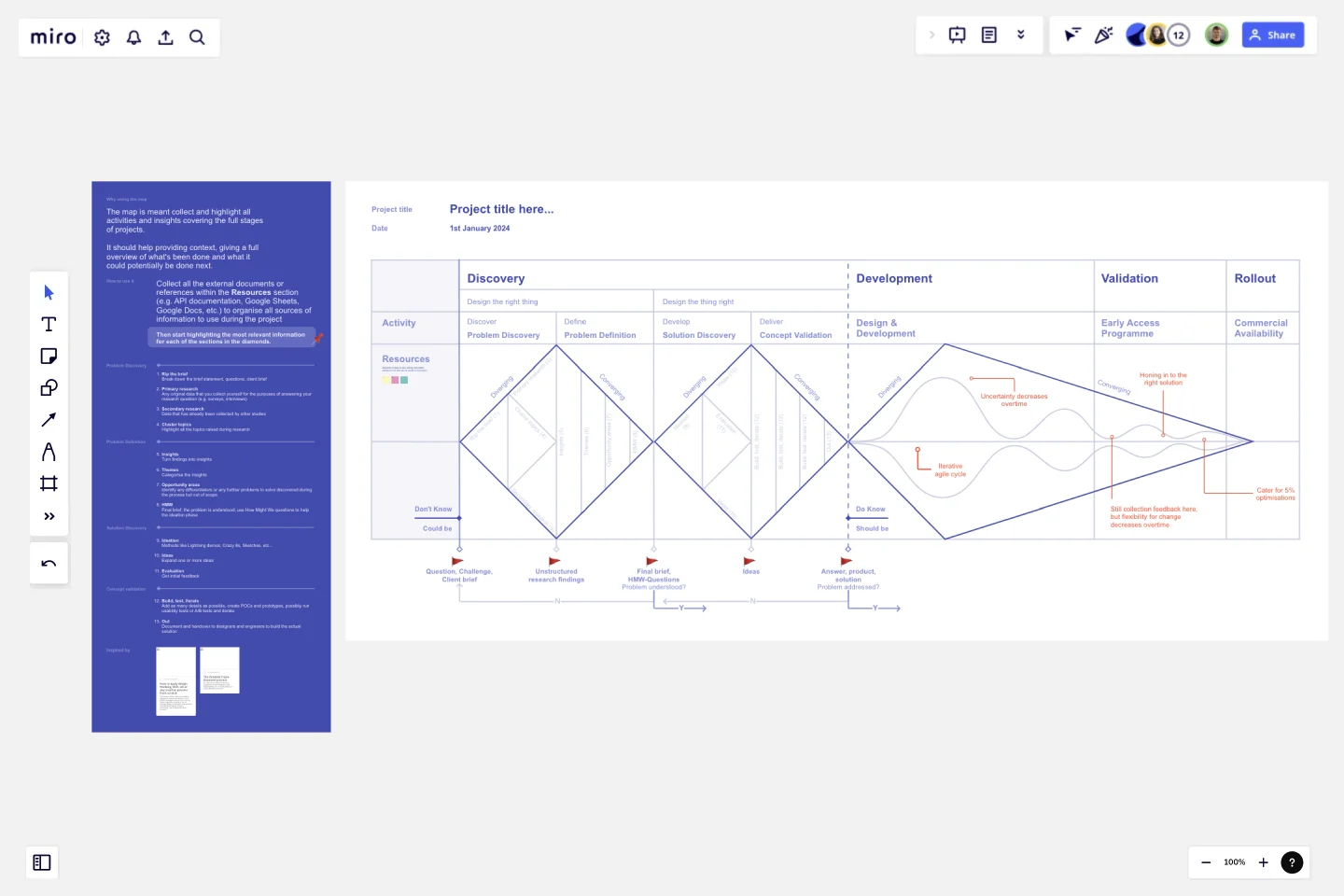[Triple Diamond] Project Map
In summary, the project map serves as a comprehensive tool for collecting, organising, and presenting information across all stages of project execution.
By providing context, highlighting past achievements, and delineating future actions, it facilitates informed decision-making, fosters collaboration, and promotes adaptive planning. As a dynamic and versatile resource, the map empowers stakeholders to navigate the complexities of project management with clarity and confidence. The purpose of the map is to comprehensively capture and illuminate all activities and insights that span across the entirety of the project stages. Its primary objective is to offer context and provide a holistic overview of past accomplishments while also delineating potential future actions.
The map serves as a repository for all project-related endeavors, encompassing initiation, planning, execution, monitoring, and closure phases. Consolidating information from each stage, it offers stakeholders a clear understanding of the project's progression and current standing.
One of the key functions of the map is to provide context. It achieves this by organizing data in a manner that illustrates the interconnectedness of various project components. Through visual representation, stakeholders can discern the relationships between different tasks, milestones, and outcomes. This contextualization facilitates informed decision-making and ensures alignment with overarching project objectives.
Moreover, the map offers a comprehensive overview of completed activities. By cataloging past accomplishments, it enables stakeholders to appreciate the journey thus far and recognise milestones achieved. This retrospective analysis not only instills a sense of progress but also provides valuable insights into the efficacy of previous approaches. Understanding what has already been accomplished serves as a foundation for devising future strategies and optimizing resource allocation.
In addition to showcasing past achievements, the map serves as a springboard for future endeavors. By delineating potential next steps, it empowers stakeholders to chart the course forward with clarity and purpose. Whether identifying areas for improvement, anticipating challenges, or exploring new opportunities, the map serves as a roadmap for informed decision-making. It not only guides strategic planning but also fosters innovation and proactive problem-solving.
Furthermore, the map facilitates effective communication and collaboration among project stakeholders. By offering a centralized platform for sharing information and insights, it promotes transparency and alignment of goals. Whether engaging with team members, clients, or external partners, stakeholders can leverage the map to convey progress, discuss strategies, and solicit feedback. This collaborative approach fosters a sense of ownership and collective responsibility, thereby enhancing overall project outcomes.
Another important aspect of the map is its adaptability. Recognising that projects are dynamic and subject to change, the map is designed to accommodate evolving circumstances and requirements. Through regular updates and revisions, it remains current and relevant, reflecting the latest developments and insights. This flexibility ensures that stakeholders are equipped with up-to-date information to make timely and informed decisions. Any feedback is appreciated if you use it for your projects!
This template was created by Stefano D'Avascio.
Get started with this template right now.
Product Strategy - Understand the "Why"
Works best for:
Product Management, Planning
The Product Strategy Understand the Why template emphasizes the importance of aligning product strategies with business objectives. By defining the "why" behind product initiatives, setting clear goals, and prioritizing initiatives, this template ensures strategic alignment and focus. With sections for articulating vision, setting objectives, and defining success criteria, it provides clarity and direction for product teams. This template serves as a strategic guide for product managers to develop and execute product strategies that drive business growth and customer value.
UML Diagram Template
Works best for:
Diagrams, Software Development
Originally used as a modeling language in software engineering, UML has become a popular approach to application structures and documenting software. UML stands for Unified Modeling Language, and you can use it to model business processes and workflows. Like flowcharts, UML diagrams can provide your organization with a standardized method of mapping out step-by-step processes. They allow your team to easily view the relationships between systems and tasks. UML diagrams are an effective tool that can help you bring new employees up to speed, create documentation, organize your workplace and team, and streamline your projects.
Simple Quarterly Product Roadmap
Works best for:
Roadmap, Planning, Mapping
Plan your product development with the Quarterly Product Roadmap template. This tool helps you outline key objectives and tasks for each quarter. Use it to set clear priorities, align your team, and track progress over time. Ideal for product managers and teams aiming to maintain focus and achieve quarterly goals. Simplify your planning process and ensure everyone is on the same page with this easy-to-use roadmap template.
Multiple-Product Roadmap
Works best for:
Planning, Mapping
The Multiple Product Roadmap template empowers product managers to visualize and manage multiple product initiatives effectively. By providing a centralized view of project timelines, dependencies, and milestones, this template fosters alignment and transparency across teams. With sections for prioritizing initiatives, tracking progress, and communicating updates, it enables teams to coordinate efforts and drive collective success. This template serves as a strategic tool for planning and executing product roadmaps that align with organizational goals and drive business growth.
UML Sequence Rental Booking System Template
Works best for:
UML
The UML Sequence Rental Booking System Template streamlines the process of documenting and visualizing the interactions within a car rental booking system. This template maps out the communication flow between the customer, user interface, payment service, and vehicle allocation system, ensuring a smooth and efficient workflow. By providing a clear visual representation of these interactions, the template helps in improving understanding among team members and stakeholders, promoting efficient design and collaboration.
Product Development Gantt Chart
Works best for:
Gantt Chart, Planning
Developing a new product involves many steps and stakeholders. The Product Development Gantt Chart template helps you manage this complex process efficiently. Use it to outline each phase of development, set timelines, and assign responsibilities. Track progress and make adjustments as needed to stay on schedule. This template provides a clear visual representation, coordinating tasks for a successful product launch.
